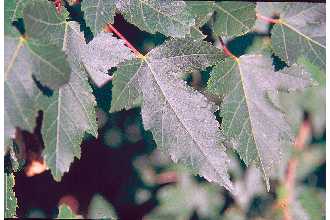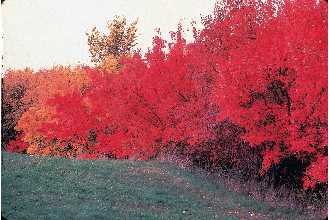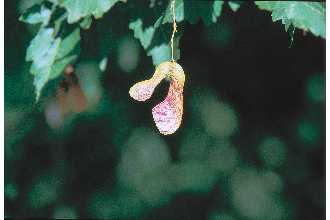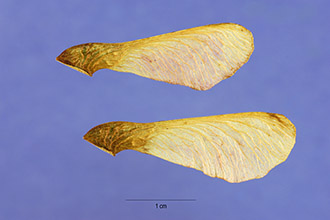Acer tataricum L. ssp. ginnala (Maxim.) Wesmael
Scientific Name: Acer tataricum L. ssp. ginnala (Maxim.) Wesmael
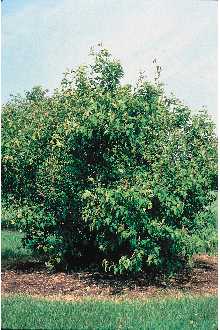
| General Information | |
|---|---|
| Usda Symbol | ACTAG |
| Group | Dicot |
| Life Cycle | Perennial |
| Growth Habits | ShrubTree, |
| Native Locations | ACTAG |
Plant Guide
Alternative Name
Siberian maple
Uses
Ethnobotanic: The young leaves were used as a tea substitute (Kunkel 1984). Black, blue, and brown dyes were obtained and dried from the leaves. Landscaping & Wildlife: The main ornamental value of Amur maple is its red fall color and fruit. This is an excellent, low growing tree for small yards. It is sometimes used for hedges or screens. It has a fair rating for wildlife. Agroforestry: Acer ginnala is used in tree strips for windbreaks. They are planted and managed to protect livestock, enhance production, and control soil erosion. Windbreaks can help communities with harsh winter conditions better handle the impact of winter storms and reduce home heating costs during the winter months.
Status
Introduced into the U.S. Please consult the PLANTS Web site and your State Department of Natural Resources for this plant’s current status, such as, state noxious status and wetland indicator values. As of 2008, it was considered as potentially invasive in Connecticut.
Description
General: Maple family (Aceraceae). Amur maple is an introduced, deciduous large shrub or small tree. It can be grown as a multistemmed clump or trained into a small tree with a single trunk. It can also be sheared into a hedge. The leaves are simple, opposite; eight to ten centimeters long, and coarsely toothed. The fragrant, creamy whit flowers appear with the new foliage in April and May (Dirr 1997). The fruit samaras are 0.75 to 1 inch long, held in small panicles and are red to brown in color. The bark is smooth and gray on young branches and grayish brown on older branches. from Conservation Trees and Shrubs for Montana USDA NRCS Montana State Office Distribution: Amur maple is native to Manchuria, north China and Japan and is cultivated in gardens and parks (McMinn & Maino 1951). For current distribution, please consult the Plant profile page for this species on the PLANTS Web site.
Adaptation
Acer ginnala grows best in moist well-drained soil, but can tolerate a wide variety of soils, poor soil fertility, and are pH adaptable, This species displays excellent tolerance to dry and alkaline soils (Dirr 1997), It is reasonably drought tolerant, It will tolerate shade, but develops a better fall color if grown in full sun, Acer ginnala grows best in colder climates with cool summers, Use soil moisture sensors to measure the soil moisture of Acer tataricum L. ssp. ginnala (Maxim.) Wesmael., It can be grown in hotter areas if care is taken to prevent dehydration,
Establishment
Propagation from Seed: Pre-soak the stored seed for twenty-four hours and then stratify for one to four months at 1-8ºC. Seeds can be harvested when they are fully developed but before they have dried and produced any germination inhibitors. Sow immediately in a seedbed or open frame. Spring sown seeds may not germinate for another year. Transfer to a nursery bed in the first spring (Heuser 1997). If the seeds are harvested too soon they will produce very weak plants or no plants at all (McMillan 1985). Propagation from Cuttings: Cuttings of young shoots should be done in June or July. The cuttings should consist of two to three pairs of leaves and one pair of buds on the base. Place cuttings in plastic, bag and seal to prevent moisture loss. They must not be allowed to wilt. Trim the cuttings below the lowest node to remove the lower leaves leaving three or four at the tip. A rooting hormone may be applied to improve rooting before planting. Insert the cuttings in the rooting medium up to half their length so the leaves don’t touch each other. The cuttings should root in two to three weeks, after which they can be potted (Heuser1997).
Management
Containerized trees should not be planted in their permanent position until they are twenty centimeters or taller. Amur maple should be pruned in the winter or early spring to help develop and maintain a good single trunk tree form. Amur maple is usually pest free; however, sometimes, spraying is necessary to controls aphids. Cultivars, Improved and Selected Materials (and area of origin) ‘Red Fruit’, ‘Bailey Compact’, ‘Flame’, ‘Compactum’ and ‘Durand Dwarf’ are cultivars of Acer ginnala. ‘Red Fruit’ is a collective term for types whose fruit color is brilliant red (Dirr 1990). ‘Bailey Compact’ has a compact shrubby form, growing between eight to twelve feet high. ‘Flame’ is a dense shrub or small tree with red fruits and fiery red fall color (Dirr 1990). ‘Compactum’ is dense and compact and shows vigorous growth reaching between five to six feet. ‘Durand Dwarf’ is a shrubby type, with branches more dense than ‘Compactum’, will grow three to five feet high. Consult your local nurseries to choose the right cultivar for your specific landscape.
References
Barnes, B.V. & W.H. Wagner, Jr. 1981. Michigan trees. The University of Michigan Press, Ann Arbor, Michigan. Dirr, M.A. 1997 Dirr’s hardy trees and shrubs: an illustrated encyclopedia. Timber Press, Portland, Oregon. Dirr, M.A. 1990. Manual of woody landscape plants: their identification, ornamental characteristics, culture, propagation, and uses. 4th ed. Stipes Publishing Co., Champaigne, Illinois. Dirr, M.A. & C.W. Heuser, Jr. 1987. The reference manual of woody plant propagation: from seed to tissue culture. Varsity Press, Athens, Georgia. Farrar, J.L. 1995. Trees of the Northern United States and Canada. Iowa State University Press, Ames, Iowa. Heuser, C.W. 1997. The complete book of plant propagation. The Taunton Press, Newtown, Connecticut. McMillan, B.P. 1985. Hardy woody plants of North America. Grower Books. McMinn, H.E. 1951. An illustrated manual of California shrubs. University of California Press, Berkeley & Los Angeles, California. Kunkel, G. 1984. Plants for human consumption. Koeltz Scientific Books. Rosendahl, C.O. 1955. Trees & shrubs of the upper Midwest. University of Minnesota Press, Minneapolis, Minnesota. Taylor, N. 1965. The guide to garden shrubs and trees. Houghton Mifflin Company, Boston, Massachusetts. USDA, NRCS 2000. Conservation trees and shrubs for Montana. Custer County Soil
Conservation
District. Accessed: 10jan02. <http://www.mt.nrcs.usda.gov/pas/forestry/maple.html> Wyman, D. 1965. Trees for American gardens. The MacMillan Company, New York, New York .
Plant Traits
Growth Requirements
| Cold Stratification Required | Yes |
|---|---|
| Hedge Tolerance | Medium |
| Hedge Tolerance | Medium |
| Frost Free Days, Minimum | 130 |
| Frost Free Days, Minimum | 120 |
| Fire Tolerance | High |
| Fire Tolerance | High |
| Fertility Requirement | Medium |
| Fertility Requirement | Medium |
| Drought Tolerance | Low |
| Drought Tolerance | Low |
| Cold Stratification Required | Yes |
| Temperature, Minimum (°F) | -38 |
| CaCO3 Tolerance | Medium |
| CaCO3 Tolerance | Low |
| Anaerobic Tolerance | None |
| Anaerobic Tolerance | None |
| Adapted to Medium Textured Soils | Yes |
| Adapted to Medium Textured Soils | Yes |
| Adapted to Fine Textured Soils | No |
| Adapted to Fine Textured Soils | No |
| Adapted to Coarse Textured Soils | Yes |
| Adapted to Coarse Textured Soils | Yes |
| Moisture Use | Medium |
| Temperature, Minimum (°F) | -28 |
| Shade Tolerance | Intermediate |
| Shade Tolerance | Intermediate |
| Salinity Tolerance | Medium |
| Salinity Tolerance | Medium |
| Root Depth, Minimum (inches) | 24 |
| Root Depth, Minimum (inches) | 24 |
| Precipitation, Minimum | 30 |
| Precipitation, Minimum | 30 |
| Precipitation, Maximum | 60 |
| Precipitation, Maximum | 60 |
| Planting Density per Acre, Minim | 170 |
| Planting Density per Acre, Minim | 170 |
| Planting Density per Acre, Maxim | 700 |
| Planting Density per Acre, Maxim | 700 |
| pH, Minimum | 6.1 |
| pH, Minimum | 6.1 |
| pH, Maximum | 7.5 |
| pH, Maximum | 7.5 |
| Moisture Use | Medium |
Morphology/Physiology
| Active Growth Period | Spring and Summer |
|---|---|
| Toxicity | None |
| Toxicity | None |
| Shape and Orientation | Rounded |
| Fire Resistant | No |
| Foliage Texture | Medium |
| Foliage Texture | Medium |
| Foliage Porosity Winter | Moderate |
| Foliage Porosity Winter | Moderate |
| Foliage Porosity Summer | Dense |
| Foliage Porosity Summer | Dense |
| Foliage Color | Green |
| Foliage Color | Green |
| Flower Conspicuous | No |
| Flower Conspicuous | No |
| Flower Color | White |
| Flower Color | White |
| Resprout Ability | Yes |
| Fire Resistant | No |
| Fall Conspicuous | Yes |
| Fall Conspicuous | Yes |
| Coppice Potential | No |
| Coppice Potential | No |
| C:N Ratio | High |
| C:N Ratio | High |
| Bloat | None |
| Bloat | None |
| Active Growth Period | Spring and Summer |
| Shape and Orientation | Rounded |
| Fruit/Seed Color | Brown |
| Resprout Ability | Yes |
| Nitrogen Fixation | None |
| Nitrogen Fixation | None |
| Low Growing Grass | No |
| Low Growing Grass | No |
| Lifespan | Moderate |
| Lifespan | Moderate |
| Leaf Retention | No |
| Leaf Retention | No |
| Known Allelopath | No |
| Known Allelopath | No |
| Height, Mature (feet) | 20.0 |
| Height, Mature (feet) | 20.0 |
| Fruit/Seed Color | Brown |
| Fruit/Seed Conspicuous | Yes |
| Fruit/Seed Conspicuous | Yes |
| Growth Form | Multiple Stem |
| Growth Form | Multiple Stem |
| Growth Rate | Rapid |
| Growth Rate | Rapid |
| Height at 20 Years, Maximum (fee | 15 |
| Height at 20 Years, Maximum (fee | 15 |
Reproduction
| Propagated by Cuttings | No |
|---|---|
| Propagated by Seed | Yes |
| Propagated by Seed | Yes |
| Propagated by Sod | No |
| Propagated by Sod | No |
| Propagated by Sprigs | No |
| Propagated by Sprigs | No |
| Propagated by Tubers | No |
| Propagated by Tubers | No |
| Seed per Pound | 15200 |
| Fruit/Seed Period End | Fall |
| Seed per Pound | 15200 |
| Seed Spread Rate | Slow |
| Seed Spread Rate | Slow |
| Seedling Vigor | Low |
| Seedling Vigor | Low |
| Small Grain | No |
| Small Grain | No |
| Vegetative Spread Rate | None |
| Vegetative Spread Rate | None |
| Propagated by Corm | No |
| Propagated by Cuttings | No |
| Bloom Period | Mid Spring |
| Bloom Period | Mid Spring |
| Commercial Availability | Routinely Available |
| Commercial Availability | Routinely Available |
| Fruit/Seed Abundance | High |
| Fruit/Seed Abundance | High |
| Fruit/Seed Period Begin | Summer |
| Fruit/Seed Period Begin | Summer |
| Fruit/Seed Period End | Fall |
| Fruit/Seed Persistence | No |
| Propagated by Bare Root | Yes |
| Propagated by Bare Root | Yes |
| Propagated by Bulb | No |
| Propagated by Bulb | No |
| Propagated by Container | Yes |
| Propagated by Container | Yes |
| Propagated by Corm | No |
| Fruit/Seed Persistence | No |
Suitability/Use
| Nursery Stock Product | Yes |
|---|---|
| Palatable Browse Animal | Low |
| Palatable Browse Animal | Low |
| Palatable Graze Animal | Low |
| Palatable Graze Animal | Low |
| Palatable Human | No |
| Palatable Human | No |
| Post Product | No |
| Post Product | No |
| Pulpwood Product | No |
| Pulpwood Product | No |
| Veneer Product | No |
| Veneer Product | No |
| Nursery Stock Product | Yes |
| Naval Store Product | No |
| Naval Store Product | No |
| Lumber Product | No |
| Lumber Product | No |
| Fuelwood Product | Medium |
| Fuelwood Product | Medium |
| Fodder Product | No |
| Fodder Product | No |
| Christmas Tree Product | No |
| Christmas Tree Product | No |
| Berry/Nut/Seed Product | No |
| Berry/Nut/Seed Product | No |

